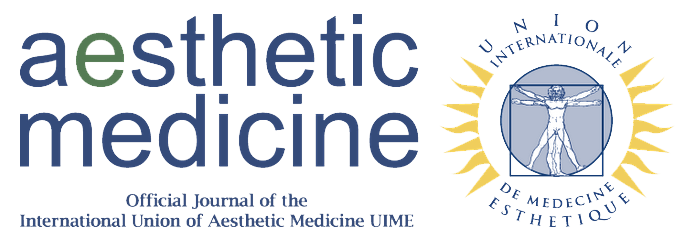Revitalization without needles: post radiation therapy scars in oncology patients
Keywords:
stimulation, oncology, hydrogen peroxide, erythema, skin lesions, post radiationAbstract
Background: High-quality non-invasive treatments, when performed by experienced professionals, can be highly beneficial for cancer patients seeking to restore the appearance and health of their skin after aggressive therapies such as chemotherapy and radiotherapy. In this report, we present a clinical case involving needle-free revitalization using a specialized protocol targeting radiation-induced scars, yielding excellent outcomes. Methods: We describe the case of a 44-year-old female oncology patient presenting with erythema and skin lesions on her arms, caused by compulsive scratching due to post-radiation pruritus. The patient underwent a combination of needle-free biostimulation (PRX-T33) and FDA-approved non-invasive microneedling (SKIN PEN). PRX-T33, a formulation containing 33% trichloroacetic acid and hydrogen peroxide, was used to stimulate dermal regeneration without causing frosting, leading to enhanced skin quality and reduction of post-treatment marks. The addition of non-invasive microneedling further promoted skin regeneration and collagen stimulation, effectively addressing acneiform scars and similar imperfections. This synergistic approach led to skin rejuvenation, regeneration, and an overall improvement in skin tone. Results: The treatment resulted in visible enhancement of skin tone and a reduction of post-aggression marks on both arms. These improvements confirmed the appropriateness of the combined therapeutic approach. Additionally, the patient expressed high satisfaction with the outcomes, further supporting the efficacy of the treatment. Conclusion: The combination of needle-free biostimulation (PRX-T33) with non-invasive microneedling (SKIN PEN) represents an effective and safe option for improving skin quality in oncology patients. The absence of adverse events highlights its suitability for this particularly sensitive patient group.
References
1. Kimura A, Kanazawa N, Li HJ, Yonei N, Yamamoto Y, Furukawa F. Influence of chemical peeling on the skin stress response system. Exp Dermatol. 2012; 21 Suppl 1:8-10.
2. Pakla-Misiur A, Grochowiec M, Lesiak A, Bednarski I. Double-blind, randomized controlled trial comparing the use of microneedling alone vs chemical peeling alone vs a combination of microneedling and chemical peeling in the treatment of atrophic post-acne scars. An assessment of clinical effectiveness and patients’ quality-of-life. Adv Dermatol Allergol. 2021; 38(4):629-635.
3. Castellana R, De Sa Viana AC, Rizzi L. Stimolazione fibroblastica attraverso l’attivazione del sistema endocrino per applicazione di acido tricloroacetico. (Fibroblast stimulation through the activation of the endocrinal system applying trichloroacetic acid). La Medicina Estetica 2013; 37(3).
4. Alqam ML, Jones BC, Hitchcock TM. Study to determine the safety and efficacy of microneedling as an effective treatment for acne vulgaris. Ski Health Dis. 2023; 385):e264.
5. A Possible and Desirable Interaction between Aesthetic Medicine and Oncology Patients. Esteban Herrero, Margarita. Medicina Estética SEME. ISSN 2696-4317 DL B 16.448-1986
Downloads
Published
Issue
Section
License
Copyright (c) 2025 Natalia Ribé Subirà

This work is licensed under a Creative Commons Attribution-NonCommercial 4.0 International License.
This is an Open Access article distributed under the terms of the Creative Commons Attribution License (https://creativecommons.org/licenses/by-nc/4.0) which permits unrestricted use, distribution, and reproduction in any medium, provided the original work is properly cited.
Transfer of Copyright and Permission to Reproduce Parts of Published Papers.
Authors retain the copyright for their published work. No formal permission will be required to reproduce parts (tables or illustrations) of published papers, provided the source is quoted appropriately and reproduction has no commercial intent. Reproductions with commercial intent will require written permission and payment of royalties.

This work is licensed under a Creative Commons Attribution-NonCommercial 4.0 International License.





